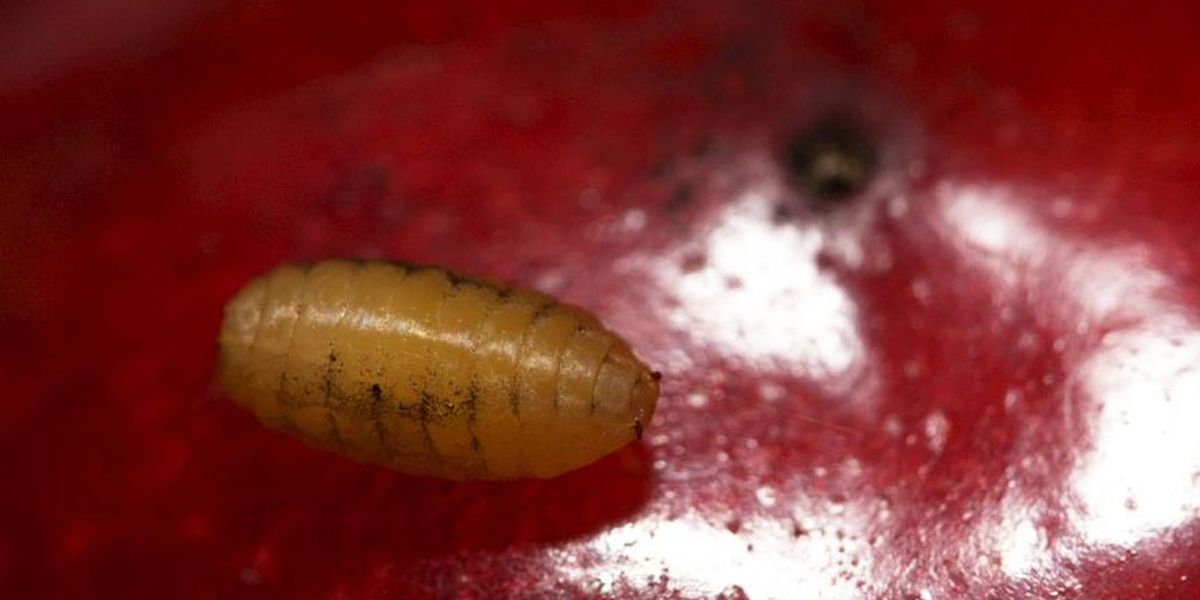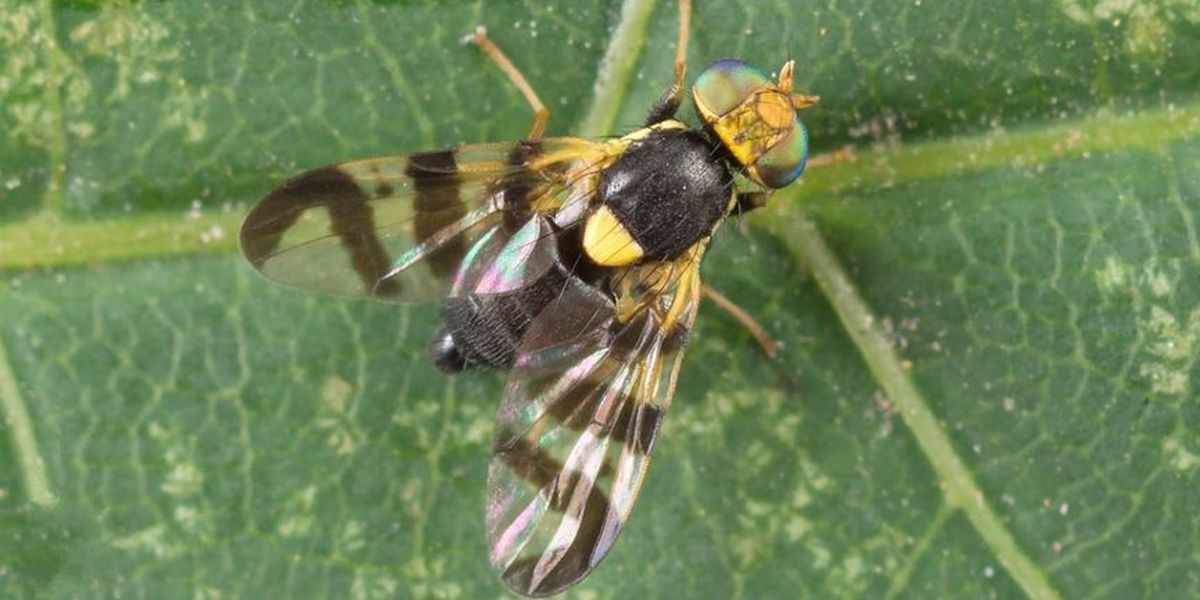Traps for catching garden pests can be viewed here.

The cherry fly - is an insect from the variegated fly family that harms cherries, sweet cherries, apricots, and honeysuckle. The larvae develop in fruits and feed on their pulp. Fruits damaged by the cherry fly darken, rot and often fall off. Reproduction is bisexual, transformation is complete. It overwinters in the pupal stage in the puparia in the soil. One generation develops per year, but some puparia go into diapause for 2-3 years.
Morphology
Imago
A fly with a body length of 2.9-5.3 mm. The abdomen and chest are black and shiny. The front of the head and forehead are yellow. The scutellum is light orange in color with four long setae, characteristic of the Piedfly family. The tibiae and tarsi are yellow, the thighs are black, and the tips of the femurs are yellowish. The wings are transparent with clearly defined four black stripes. The first two stripes from the base of the wing do not reach its inner edge, the third is short. The insect's eyes are green. On the sides of the chest there are two longitudinal wide yellow stripes.

Sexual dimorphism
In males, the third stripe from the base of the wing merges with the upper part with the fourth wide V-shaped stripe, passing through the entire surface of the wing. In the female these stripes do not merge. The abdomen of the female is much larger than that of the male, sharpened in the upper part and ends with an ovipositor, which is retracted into the abdomen in a calm state. The body length of the female is 3.8-5.3 mm, the male is slightly smaller - 2.9-4.0 mm.
Egg
The color of the cover is yellowish-white. The shape is an elongated ellipse, pointed at the top. The surface of the egg is smooth. In the upper part there is a faintly visible pattern of intersecting lines that form cells of a hexagonal configuration. Egg dimensions - 0.75 x 0.22 mm.
Larva
The worm-shaped, legless body of the larva tapers towards the head end and consists of 13 segments. The color of the cover is white. The oral apparatus is visible through the thin covering. Heavily chitinized jaw hooks have a tooth on the inside. There are no dental sclerites. The anterior spiracles have 14-16 lobes. The preoral teeth are dark, large, 4-5 on each side.
The larva goes through three generations:
I generation. Body length - 0.65-1.74 mm. Thoracic spiracles are absent. Posterior spiracles with two round openings, very small.
II generation. Body length - 1.8-3.65 mm. There are thoracic spiracles, the posterior spiracles become large, with three oval-shaped spiracular slits.
III generation. Body length - up to 6-7 mm. The anterior and posterior spiracles are well developed. The posterior ones are provided with elongated, straight spiracular slits.

Pupa
The pupa is located inside the puparia. It is motionless and has well-defined rudiments of adult organs. The length of the puparia is 2.5-4.5 mm. The color is straw yellow. The puparia has the hardened skin of the third instar larva and retains its structural features. The puparia shows segmentation, surface sculpture, posterior spiracles and anal plate.
A fly with a body length of 2.9-5.3 mm. The abdomen and chest are black and shiny. The front of the head and forehead are yellow. The scutellum is light orange in color with four long setae, characteristic of the Piedfly family. The tibiae and tarsi are yellow, the thighs are black, and the tips of the femurs are yellowish. The wings are transparent with clearly defined four black stripes. The first two stripes from the base of the wing do not reach its inner edge, the third is short. The insect's eyes are green. On the sides of the chest there are two longitudinal wide yellow stripes.

Sexual dimorphism
In males, the third stripe from the base of the wing merges with the upper part with the fourth wide V-shaped stripe, passing through the entire surface of the wing. In the female these stripes do not merge. The abdomen of the female is much larger than that of the male, sharpened in the upper part and ends with an ovipositor, which is retracted into the abdomen in a calm state. The body length of the female is 3.8-5.3 mm, the male is slightly smaller - 2.9-4.0 mm.
Egg
The color of the cover is yellowish-white. The shape is an elongated ellipse, pointed at the top. The surface of the egg is smooth. In the upper part there is a faintly visible pattern of intersecting lines that form cells of a hexagonal configuration. Egg dimensions - 0.75 x 0.22 mm.
Larva
The worm-shaped, legless body of the larva tapers towards the head end and consists of 13 segments. The color of the cover is white. The oral apparatus is visible through the thin covering. Heavily chitinized jaw hooks have a tooth on the inside. There are no dental sclerites. The anterior spiracles have 14-16 lobes. The preoral teeth are dark, large, 4-5 on each side.
The larva goes through three generations:
I generation. Body length - 0.65-1.74 mm. Thoracic spiracles are absent. Posterior spiracles with two round openings, very small.
II generation. Body length - 1.8-3.65 mm. There are thoracic spiracles, the posterior spiracles become large, with three oval-shaped spiracular slits.
III generation. Body length - up to 6-7 mm. The anterior and posterior spiracles are well developed. The posterior ones are provided with elongated, straight spiracular slits.

Pupa
The pupa is located inside the puparia. It is motionless and has well-defined rudiments of adult organs. The length of the puparia is 2.5-4.5 mm. The color is straw yellow. The puparia has the hardened skin of the third instar larva and retains its structural features. The puparia shows segmentation, surface sculpture, posterior spiracles and anal plate.
Development
Imago
In spring, the puparia ruptures in the transverse direction in the area of the second or third segment of the head part, and the formed fly emerges to the surface. The minimum sum of effective temperatures that determines the final development of the pupa and the appearance of the first flies in the crown is 190° at a temperature of 10°C. The newly hatched fly is reddish-gray and inactive. 4-5 hours after birth, the fly acquires normal color, dries out, spreads its wings and rises into the crown. In the conditions of southern Ukraine, the emergence of flies lasts from mid-May to mid-July. Males are the first to be reborn, followed by females after 4-5 days. Additionally, insects feed on leaf secretions and the juice of ripe fruits. The period of additional nutrition lasts 12-14 days.

Mating period
The mating period occurs in warm sunny weather, at a temperature of at least + 18 ° C. At temperatures below 15 ° C, flies are inactive, they do not mate and do not lay eggs. In warm but cloudy weather, they are also inactive and hide on the underside of the leaf blade or on the surface of the soil. The female lays eggs in green and mature fruits of fodder trees. The process takes about four minutes. The female examines the fetus, then places the ovipositor perpendicular to its surface and inserts it inside with rhythmic movements. As soon as the ovipositor is inserted, the female freezes and, straining her tummy, pushes out the egg. On green fruits, the oviposition site appears as a barely noticeable dot. The female lives for about a month and lays about 150 eggs.
Egg
Embryonic development lasts 6-10 days.
Larva
After rebirth, the larva feeds on the pulp of the fruit and gradually moves towards the stone. Development occurs in 16-20 days. During this time, she molts twice and, having reached the third instar, moves into the soil to pupate. Most pests leave fruits even before they are removed from the tree. The larva penetrates 2-5 cm into the soil, and within a few hours a puparia forms around it.
Pupa
The pupa is formed inside the puparia 5-6 days after the larva leaves the soil. In this state the insect overwinters. The bulk of puparia are located within the crown projection. About 14% of pupae enter diapause and complete their development only after the second or third wintering. The development of the pupa begins when the temperature in the soil at a depth of 5 cm rises to + 10°C.

In spring, the puparia ruptures in the transverse direction in the area of the second or third segment of the head part, and the formed fly emerges to the surface. The minimum sum of effective temperatures that determines the final development of the pupa and the appearance of the first flies in the crown is 190° at a temperature of 10°C. The newly hatched fly is reddish-gray and inactive. 4-5 hours after birth, the fly acquires normal color, dries out, spreads its wings and rises into the crown. In the conditions of southern Ukraine, the emergence of flies lasts from mid-May to mid-July. Males are the first to be reborn, followed by females after 4-5 days. Additionally, insects feed on leaf secretions and the juice of ripe fruits. The period of additional nutrition lasts 12-14 days.

Mating period
The mating period occurs in warm sunny weather, at a temperature of at least + 18 ° C. At temperatures below 15 ° C, flies are inactive, they do not mate and do not lay eggs. In warm but cloudy weather, they are also inactive and hide on the underside of the leaf blade or on the surface of the soil. The female lays eggs in green and mature fruits of fodder trees. The process takes about four minutes. The female examines the fetus, then places the ovipositor perpendicular to its surface and inserts it inside with rhythmic movements. As soon as the ovipositor is inserted, the female freezes and, straining her tummy, pushes out the egg. On green fruits, the oviposition site appears as a barely noticeable dot. The female lives for about a month and lays about 150 eggs.
Egg
Embryonic development lasts 6-10 days.
Larva
After rebirth, the larva feeds on the pulp of the fruit and gradually moves towards the stone. Development occurs in 16-20 days. During this time, she molts twice and, having reached the third instar, moves into the soil to pupate. Most pests leave fruits even before they are removed from the tree. The larva penetrates 2-5 cm into the soil, and within a few hours a puparia forms around it.
Pupa
The pupa is formed inside the puparia 5-6 days after the larva leaves the soil. In this state the insect overwinters. The bulk of puparia are located within the crown projection. About 14% of pupae enter diapause and complete their development only after the second or third wintering. The development of the pupa begins when the temperature in the soil at a depth of 5 cm rises to + 10°C.

The cherry fly harms cherries, cherries, apricots and honeysuckle in the larval stage, developing in the fruits and feeding on their pulp, which it turns into a mushy mass. Damaged fruits darken, rot and often fall off. Early varieties of cherries and sweet cherries are especially affected by the pest. In the south of Ukraine, the harmfulness reaches 50-80%. Such fruits cannot be used either fresh or for preservation.


